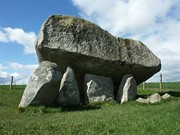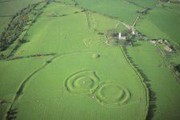Irish Stone Age Art
Prehistoric Megaliths and Tombs in Ireland,
like Newgrange and Knowth.
![]()
![]()
|
Irish Stone Age Art |
 Brownshill Dolman, County Carlow (c.4900-5500 BCE); example of Megalith Prehistoric Art. See also: Prehistoric Art Timeline. |
Stone Age Art and Culture in IrelandEarly facts about Stone Age culture and civilization in Ireland derive from archeological excavation, supported by accounts in Irish mythology and poems. There is scant archeological evidence of human activity in Ireland during the Upper Paleolithic (40,000 to 10,000 BCE), the period that coincided with most of the cave art produced in Europe. Indeed it wasn't until the era of Mesolithic art, about 7500 BCE, that the first settlements appeared. The first of these prehistoric Irish communities have been traced to County Derry, County Antrim, County Sligo, County Offaly, the Shannon estuary and areas of Munster. These Mesolithic settlers - no more than a few thousand - probably crossed the Irish Sea from Scotland, bringing a primitive hunter-gatherer culture with them. |
 Aerial View of Tara Mounds, County Meath, (c.2000 BCE). |
Neolithic Era As hunter-gathering gave way to agriculture and animal husbandry during the era of Neolithic art (4,500-2,000 BCE) - witness the large Neolithic Céide Fields network in County Mayo - settlement expanded across Ireland and the population surged to 100,000 or more. Pottery such as round-bottomed bowls began to appear, along with other typical forms of primitive Irish art reflecting the typical neolithic culture of the late Stone Age and early Bronze Age. |
|
HISTORICAL IRISH MONUMENTS |
Megalithic Artworks However, in addition to these predictable forms of art, Neolithic Ireland witnessed a cultural phenomenon in the construction of over 1200 megalithic monuments (chiefly tombs), with complex religious and ceremonial significance: (note: in archeology, megaliths are large stones forming part of a monument). As well as human remains, excavations at these sites have revealed quantities of pottery, beads, pendants, cooking utensils and weaponry such as axes and arrowheads. These megalithic burial monuments may be grouped into four categories: Court, Passage, Portal and Wedge tombs, and date from about 3500 BCE onwards - that is, slightly later than tombs found in Brittany and Spain. In all cases, these burial constructions reflect a new cultural maturity in Ireland. Decorative arts had a new religious and ceremonial focus which presaged the growth of Celtic art among later generations of early Irish artists. Newgrange The oldest group of megaliths are Court Tombs, uncovered mainly in the North of Ireland. The next group, featuring the largest of type of Neolithic necropolis cemetery - known as Passage Tombs - occur mainly in the north and east of Ireland. The best example is the Newgrange megalithic passage tomb (Dún Fhearghusa) (c.3200 BCE), part of the Brú na Bóinne complex in County Meath, and now a World Heritage Site. The early history of Irish visual art is generally believed to begin with early megalithic art - mostly stone carvings - found at burial mounds such as Newgrange. At the Knowth megalithic tomb, another of the Boyne burial chambers, archeologists unearthed what is believed to be the first recorded map of the moon. This lunar plan was carved into the rock. The third category of megalithic monument, found in both the South and North of Ireland, are Portal Tombs. These include the famous dolmens - which are prehistoric tombs featuring a large flat stone laid upon upright stones. Good examples were uncovered at Knockeen and Gaulstown in County Waterford. The last and most widespread are Wedge Tombs, built in late Neolithic times mainly in the west and southwest of Ireland, especially County Clare. |
|
When assessing early culture and civilization in Ireland, in which these megaliths play such an important early role, several points are worth noting. First, none of the complex passage tombs could have been built without enormous organization and resources. This suggests a strong religious and social system among a reasonably large and well resourced population. Second, construction was both complex as well as intricately oriented to mesh with solar and lunar alignments, indicating a relatively high degree of awareness of the natural world, at least among Ireland's ruling class. Thirdly, the intricate layout of many megalithic monuments, which included chambers designed for ceremonies, meetings and other social and cultural activities, suggests that they were far from being mere burial monuments. For example, Westminster Cathedral contains numerous sarcophagi and tombs, but it could hardly be classified as a burial monument. In any event, construction of these early ceremonial sites heralded increasing settlement, as well as greater security, which led to the appearance of a range of artworks in the succeeding Bronze and Iron Age. Population Decline During the late Neolithic era, Ireland's population climbed above 100,000 for the first time, and may even have nudged 200,000. Exactly how this Neolithic population surge occurred is unknown. More settlers undoubtedly arrived from the British mainland, but anthropological and DNA research shows strong genetic links between Irish people and those in Iberia (Spain and Portugal). Whether the solar alignment of Ireland's megalith architecture denotes a familiarity with solar navigation which might have led to maritime contact between the two cultures remains an open question. According to archeological evidence, Ireland's population declined during the middle of the Bronze Age around 2400-2300 BCE. Whether this was due in part to volcanic eruptions at Hekla in Iceland (c.2345 BCE) or local disaster is not known. |
|
• For information about the cultural
history of Stone Age Ireland, see: Irish
Art Guide. ENCYCLOPEDIA OF IRISH AND CELTIC ART |